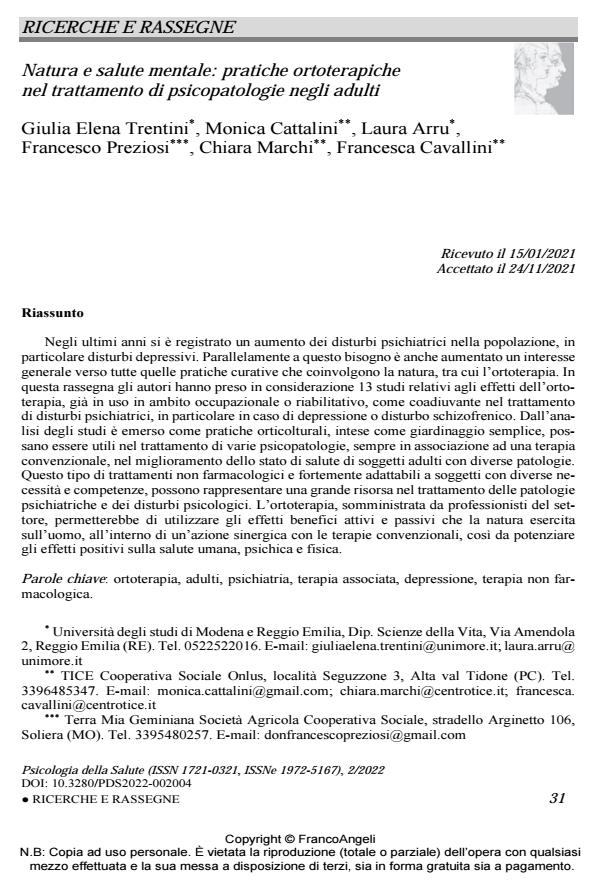Nature and mental health: horticultural therapy for adults with psychopathologies
Journal title PSICOLOGIA DELLA SALUTE
Author/s Giulia Elena Trentini, Monica Cattalini, Laura Arru, Francesco Preziosi, Chiara Marchi, Francesca Cavallini
Publishing Year 2022 Issue 2022/2
Language Italian Pages 24 P. 31-54 File size 312 KB
DOI 10.3280/PDS2022-002004
DOI is like a bar code for intellectual property: to have more infomation
click here
Below, you can see the article first page
If you want to buy this article in PDF format, you can do it, following the instructions to buy download credits

FrancoAngeli is member of Publishers International Linking Association, Inc (PILA), a not-for-profit association which run the CrossRef service enabling links to and from online scholarly content.
In recent years there has been an increase in psychiatric disorders in the population, particu-larly depressive disorders. Parallel to this need, there has also been a general increase in interest in all healing practices involving nature, including horticultural therapy. In this review, the au-thors considered 13 studies on the effects of horticultural therapy, which is already used for example in occupational therapy or rehabilitation, as an adjunct in the treatment of psychiatric disorders, in particular depressive disorders, and schizophrenia. The analysis of the studies showed that horticultural practices, understood as simple gardening, can be useful in the treat-ment of various psychopathologies, again in combination with conventional therapy, to im-prove the health status of adults with various pathologies. This type of treatment, which is non-pharmacological and highly adaptable to subjects with different needs and abilities, can be a great resource in the treatment of psychiatric pathologies and psychological disorders. Horticul-tural therapy, administered by professionals, would make it possible to use the active and pas-sive beneficial effects that nature exerts on humans, in a synergistic action with conventional therapies, to enhance the positive effects on human, mental and physical health.
Keywords: horticultural therapy, psychiatric, adult, depression, associated treatment, non drug therapy.
Giulia Elena Trentini, Monica Cattalini, Laura Arru, Francesco Preziosi, Chiara Marchi, Francesca Cavallini, Natura e salute mentale: pratiche ortoterapiche nel trattamento di psicopatologie negli adulti in "PSICOLOGIA DELLA SALUTE" 2/2022, pp 31-54, DOI: 10.3280/PDS2022-002004